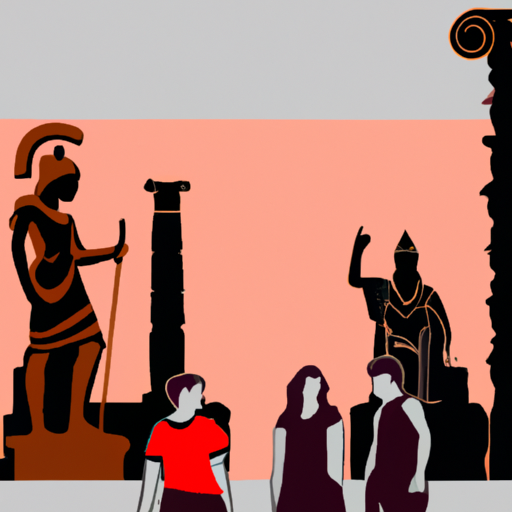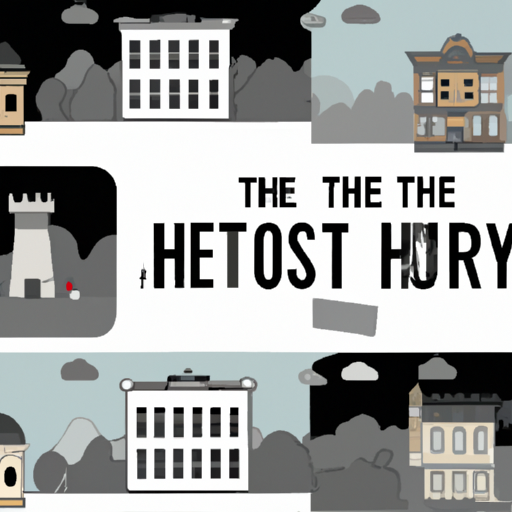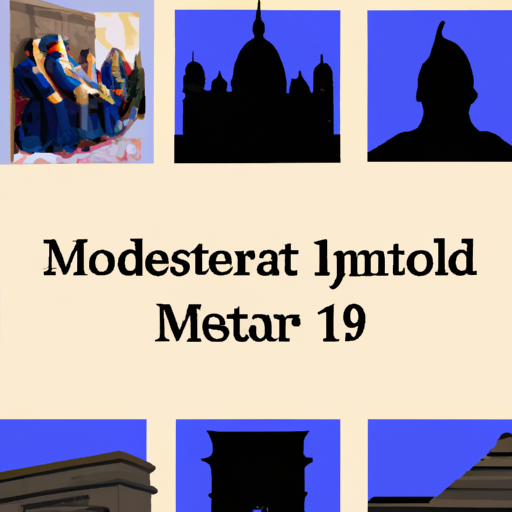Exploring the History of the 5 Most Mysterious Lost Civilizations
Unearth the mysteries of days gone by! Discover the hidden societies that have been lost to time! Unravel the enigmas of ages past and uncover a wealth of knowledge about bygone eras. Delve into the unknown and explore the forgotten realms of our collective history. Unlock secrets that were once thought to be lost forever, and uncover the truth behind these ancient civilizations!

For centuries, humans have been captivated by the unknowns of our past. From long-lost civilizations to societies that were lost in more recent times, there is much to be unearthed from our history. Uncovering these hidden histories can provide us with invaluable insight into our collective heritage and help us better comprehend our place in the world today.
One such civilization is the Minoans of Crete, who flourished around 2000 BC until they were wiped out by a massive volcanic eruption. This society developed a complex culture and advanced architecture, as well as an extensive trading network that reached far beyond their island home. The Minoan legacy still remains today in works such as the palace at Knossos and frescoes depicting bull-leaping rituals.
The Olmecs of Central America also left behind evidence of their civilization between 1200-400 BC. They are renowned for their artistry and technological achievements, particularly their colossal stone heads which still stand today as testament to their ingenuity. The Olmecs also left behind evidence of a complex religion and an advanced writing system known as Isthmian Script which remains undeciphered to this day.
In Africa, we find evidence of two more lost societies: The Kingdom of Aksum (100-940 AD) and Great Zimbabwe (11th – 15th century). Both were powerful empires that dominated their respective regions during their time periods and left behind impressive monuments such as stelae and stone walls. Aksum was especially influential in trade with other nations while Great Zimbabwe had its own unique architectural style which has become iconic in southern African culture today.
Finally, Easter Island (Rapa Nui), located off the coast Chile, was once home to a thriving population whose sophisticated culture included monumental statues known as moai which still stand on its shores today despite centuries of erosion and neglect. Unfortunately, this society ultimately collapsed due to overpopulation and environmental degradation, leaving only these mysterious reminders of its existence.
From Crete to Chile, these five forgotten societies offer us a glimpse into our distant pasts and remind us how much there is still left unexplored about history!
.
Introduction

Tales of forgotten civilizations that have been lost to time, leaving behind only fragments of their legacy, are a source of great fascination. From the ancient Egyptians to the Aztecs, there are many lost societies whose influence is still felt today. Here are five of the most mysterious:
1. The Minoans: This Bronze Age civilization flourished on the island of Crete from 2000-1450 BC, renowned for their sophisticated architecture, art, and trading networks. Unfortunately, it was destroyed by a volcanic eruption on Thera in 1628 BC.
2. The Olmecs: This Mesoamerican culture thrived from 1200-400 BC in what is now Mexico’s Gulf Coast region. They developed a writing system, constructed impressive pyramids and monuments, and created intricate artwork depicting gods and goddesses.
3. The Indus Valley Civilization: This ancient society existed along the Indus River in modern day Pakistan and India from 3300-1300 BC; one of the first urban cultures in South Asia with advanced plumbing systems, captivating artworks, and an undeciphered script.
4. The Maya: This Mesoamerican civilization spanned 2000 BC to 1600 AD across southern Mexico, Guatemala, Belize, El Salvador, and Honduras. They built an advanced calendar system as well as hieroglyphic writing which they used to record their history and mythology.
5. The Lost City of Atlantis: Legends tell of this legendary city located somewhere in the Atlantic Ocean thousands of years ago before its sudden disappearance beneath the waves due to some unknown calamity or mistake – yet no evidence has ever been found despite centuries of searching by archaeologists and treasure hunters alike!
– History of the Ancient Sumerian Civilization
Dating back to a time of antiquity, the Sumerian civilization flourished in the Mesopotamian region from 4500 BC. This ancient society was renowned for its influential accomplishments, such as introducing writing, irrigation systems and even the wheel. Their mathematical knowledge and religious beliefs left an indelible mark on history, inspiring later civilizations in Egypt and Babylon.
Organized into city-states ruled by monarchs or priest-kings, Sumerians were often engaged in warfare against each other, yet also exchanged goods and ideas. Their legal system was intricate and their cuneiform language used wedge-shaped symbols to represent words and concepts; this enabled them to record laws, business transactions and religious ceremonies.
Theocracy was an advanced form of governance practiced by the Sumerians; priests ruled in the name of gods like Anu and Enlil who they believed controlled different aspects of nature. The culture of this ancient civilization has had a lasting impact on modern life through its contributions to art, literature, architecture, mathematics, astronomy, engineering, law codes, medicine, music theory and more.
– Uncovering the Lost History of the Harappan Civilization
Mysterious and captivating, the Harappan civilization has long enthralled archaeologists and researchers. Discovered in the 1920s, its secrets remain deeply buried, prompting a flurry of archaeological research to uncover its lost history.
The evidence unearthed so far suggests that the Harappan people were a highly advanced society with sophisticated systems for trading goods, writing and art, as well as complex religious beliefs. Unfortunately, due to the lack of written records, much about their culture remains unknown.
In an effort to learn more about this ancient civilization, modern technology such as aerial photography and satellite imagery are being used to map out sites that may contain clues about the Harappans’ past. Additionally, artifacts found at these sites are being studied to gain further insight into their culture and beliefs. By combining these methods, researchers hope to gain a better understanding of this lost civilization’s history.
This knowledge can provide us with invaluable information on how early societies developed and evolved over time which can be used to inform our own development in the future; thus allowing us to gain a greater appreciation for our shared human heritage.
– Exploring the Mysterious Olmec Civilization
Mysterious and perplexing, the Olmec culture has captivated historians for centuries. Emerging around 1200 B.C., this ancient Mesoamerican civilization flourished until 400 B.C., leaving behind a wealth of artifacts, monuments, and art that continue to elude scholars. Primarily located in present-day Veracruz and Tabasco states along Mexico’s Gulf Coast, this advanced culture had complex systems of government, trading, and religion. Among their most notable creations are massive stone heads carved from basalt depicting important figures in their society – a feat that still astounds researchers today. Additionally, they crafted pottery, figurines, jewelry, and other objects out of jade and obsidian.
The Olmecs were also proficient farmers who grew maize (corn), beans, squash, tomatoes, chili peppers, avocado and amaranth as well as hunted deer for food and traded with neighboring communities for salt or shells. Scholars have yet to decipher the writing system they developed using symbols called glyphs which speaks to the complexity of their civilization. Furthermore, due to lack of written records from the time period there is much unknown about their religious beliefs; however through analyzing sculptures depicting gods or rituals involving jade masks or offerings of food or drink placed at temple sites it appears that their religion was polytheistic with many gods associated with different aspects of nature such as rain or fertility.
The influence of the Olmecs can be seen in later Mesoamerican cultures like the Maya who adopted many aspects of their culture including writing systems and religious beliefs which are still visible in modern day Mexico today. Uncovering the secrets of this enigmatic culture continues to be an intriguing endeavor that offers us an opportunity to better understand our past and gain insight into how civilizations evolve over time.
– Investigating the Minoan Civilization of Crete
The Minoan Civilization of Crete – a Bronze Age culture that flourished on the Mediterranean island from roughly 2700 to 1450 BC – has long been a source of fascination for archaeologists and historians alike. Through artifacts, ruins, frescoes, pottery, jewelry, and written records in Linear A and Linear B scripts, we can gain an understanding of this ancient society’s lifestyle and beliefs.
Crete was situated at a crossroads between Europe and Africa, making it an ideal trading hub for goods from across the Mediterranean region. It is also believed to have had contact with mainland Greece due to its association with the Labyrinth built by Daedalus for King Minos as described in Homer’s epic poem “The Odyssey”.
By studying the material remains left behind by this civilization along with its historical context, we can gain an appreciation for how advanced it was compared to other societies at the time. Examining the Minoan Civilization of Crete provides us with invaluable insight into one of humanity’s earliest civilizations and helps us better understand our own history.
– Discovering the Secrets of the Maya Civilization
For centuries, the enigmatic Maya civilization has captivated outsiders with its mysterious history and advanced culture. From their sophisticated system of writing and mathematics to their impressive cities built with stone pyramids, temples, plazas, and palaces – the Maya have left a lasting legacy.
Recent archaeological discoveries have shed light on some of the secrets that have remained hidden for so long. The Maya were experts in astronomy and mathematics – they developed an accurate calendar system to predict eclipses and other astronomical events as well as a complex written language known as hieroglyphics.
In addition to their remarkable architecture, the Maya also had advanced agricultural techniques such as terracing fields for irrigation and crop rotation to maintain soil fertility. They also developed systems for draining swamps which allowed them to cultivate land in areas where it would otherwise be impossible to do so.
The sudden collapse of the Maya civilization around 900 AD remains largely unexplained, yet archaeologists continue to uncover new information about this mysterious culture every day. As more is uncovered, we are slowly piecing together what life was like during this period in history.
conclusion

It has been said that five civilizations, shrouded in a veil of mystery, were lost to the annals of history. Who were they? What did they contribute? How did their culture shape our understanding of the world’s past? These questions remain unanswered, and yet, clues left behind by these ancient societies offer us a glimpse into their lives and legacies. The Minoans, Mycenaeans, Harappan, Olmecs and Mayans are all part of this mysterious puzzle; each one providing insight into the forgotten stories of our past.
.
Some questions with answers
Q1: What are the 5 lost civilizations?
A1: The five lost civilizations are the Indus Valley Civilization, the Minoan Civilization, the Olmec Civilization, the Maya Civilization and the Easter Island Civilization.
Q2: When did these civilizations exist?
A2: The Indus Valley Civilization existed from 3300 to 1300 BCE, the Minoan Civilization existed from 2600 to 1100 BCE, the Olmecs existed from 1500 to 400 BCE, the Maya existed from 2000 BCE to 1697 CE and Easter Island was settled around 1200 CE.
Q3: What is known about these civilizations?
A3: These ancient cultures all had advanced societies with complex architecture and social systems. They also developed their own writing systems and religious beliefs. They were all eventually destroyed by natural disasters or invaders.
Q4: What can we learn from these civilizations?
A4: By studying these civilizations, we can learn about how people lived in different times and places. We can also gain insight into our own society by looking at how these ancient cultures organized themselves and interacted with their environment.
Q5: Where can I learn more about them?
A5: You can find more information on these lost civilizations in books, articles and websites dedicated to history. Museums are also great places to explore artifacts that belonged to these ancient cultures.




